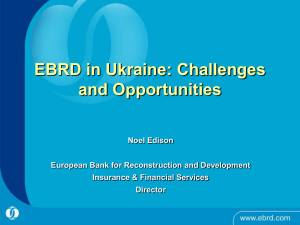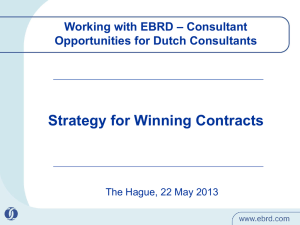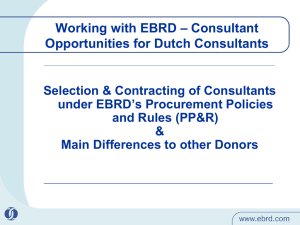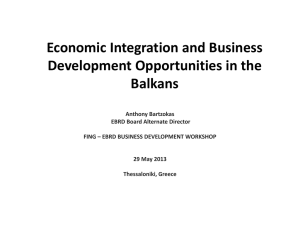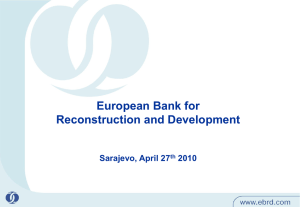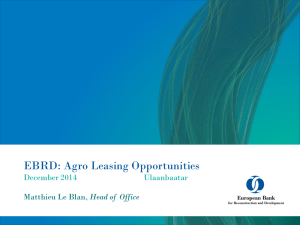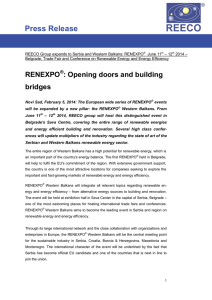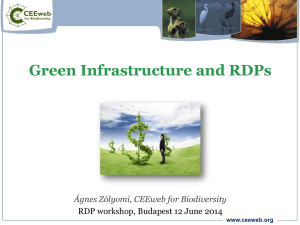EBRD - Balkan Magazin
advertisement
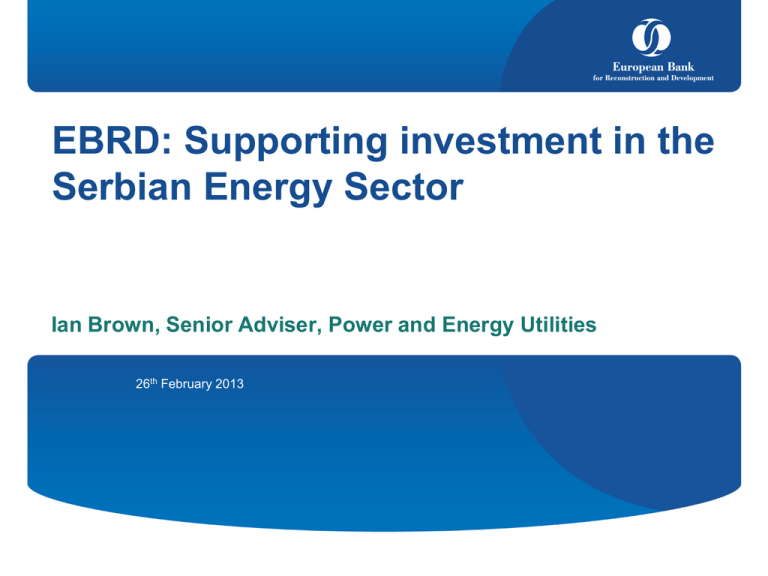
EBRD: Supporting investment in the Serbian Energy Sector Ian Brown, Senior Adviser, Power and Energy Utilities 26th February 2013 AGENDA I. Overview of EBRD: Mission and Guiding Principles II. EBRD in Serbia III. Power & Energy Utilities: Focus and experience IV. Investment in Generation: Issues and Experience V. Financing renewable energy in Serbia 2 AGENDA I. Overview of EBRD: Mission and Guiding Principles II. EBRD in Serbia III. Power & Energy Utilities: Focus and experience IV. Investment in Generation: Issues and Experience V. Financing renewable energy in Serbia 3 EBRD’s objectives achieved through financing the private sector • AAA/Aaa stable rated multilateral development bank owned by 63 countries and 2 multinational entities • Invested over €78.9 billion in more than 3,644 projects since 1991 • In 2012: – €8.9 billion invested in 393 projects in 2012 – Private sector accounted for 80% share – Debt 87.5%; Equity 12.5% Note: Provisional data as at 31 December 2012 € billion 34 countries of operation and 39 resident offices 5 AGENDA I. Overview of EBRD: Mission and Guiding Principles II. EBRD in Serbia III. Power & Energy Utilities: Focus and experience IV. Investment in Generation: Issues and Experience V. Financing renewable energy in Serbia 6 EBRD in Serbia • Country of operation since 2001 • Total cumulative commitments of € 3.11bn as of Dec 2012 • Private sector participates with 45% in total cumulative commitments Total outstanding portfolio of € 2.34bn, comprised of 123 active operations • In 2012, invested € 270 million in 20 projects • In 2013, plan to invest € 300 million in 20 projects or more • Team of 22 people in Resident Office in Belgrade • Objectives: To promote a sound investment climate, good corporate governance and stronger institutions Serbia: Cumulative Commitments Composition (€ m) 452 15% 1,086 35% 716 23% 852 27% Infrastructure Financial Institutions Industry, Commerce and Agribusiness Power and Energy EBRD Facilities LOANS • Project finance loans • Corporate loans with specified use of proceeds • Tenor of 10-15 years EQUITY • EBRD equity stake typically below 2025% (meaningful, but minority) • Investment through capital increase • Invest in Funds to address smaller projects or larger stakes • Margin benchmarked to market • Fixed rate and/or local currency possible • Exit through IPO, trade sale or put/call agreement • Political and regulatory risk mitigation • EBRD can directly finance up to 35% of an enterprise's long term capital (or project costs for greenfield projects); additional funds mobilised through syndication 9 Leveraging commercial finance • Catalyst for commercial investment: Every €1 invested or lent by the EBRD mobilises €3.1 from other sources • Equity: by investing as a minority shareholder we reduce the equity burden and add value through partnership • Debt syndication: The EBRD can syndicate all or part of the senior debt under A/B structures • Debt co-financing: The EBRD will work with or alongside other commercial banks to provide the appropriate debt package 10 AGENDA I. Overview of EBRD: Mission and Guiding Principles II. EBRD in Serbia III. Power & Energy Utilities: Focus and experience IV. Investment in Generation: Issues and Experience V. Financing renewable energy in Serbia 11 Primary objectives • Support sector reforms that enable energy sectors to function according to market principles (e.g. increased competition, market liberalization and private ownership) • Strengthen frameworks for regionalisation (trans-border transmission lines, energy trading) • Prioritise environmental, energy efficiency and renewable energy investments 12 Financings by sector Financing by Sector (2009-2012) Natural Gas Distribution 2% Electric Power Distribution 13% Renewable Power 27% • Cumulative EBRD financing to power & energy projects since 1992 is €8.1 bn across 170 projects with €28.4 bn total value • In 2012 invested over €1.0 bn in 23 projects with a total value of €3.2 bn • In the last five years, number of projects per year has tripled and annual business volume has quadrupled Electric Power Transmission 9% Electric Power Generation 49% • Renewables represent an increasing portion of total financing, comprised primarily of wind and hydro but also including biomass and solar Unaudited as at 31 December 2012 Note: Renewable power does not include large hydro. Source: EBRD data 13 Focus on renewables Renewables financing by technology (2009-2012) Wind 72% Hydro 16% Various 7% 1 Biomass 4% Solar 1% • In 2012 the EBRD signed €305mln of financing for 14 renewables deals with a total gross project value of €960 mln • Notable transactions in 2012 include the following wind farms: Salkhit (Mongolia), Kukinia (Poland), Chirnogeni (Romania), Bares (Turkey) • Technologies financed to date include wind (about 72%), hydro (about 16%), biomass (about 4%) and solar (less than 1%). Note that hydro includes greenfield small hydro and hydro rehabilitation, but not greenfield large hydro Unaudited as at 31 December 2012 Note: Renewable power does not include large hydro. Source: EBRD data (1) Various includes investment in funds that finance a mix of technologies. • The EBRD has been most active in financing renewables projects in Poland, Ukraine, Turkey and Romania AGENDA I. Overview of EBRD: Mission and Guiding Principles II. EBRD in Serbia III. Power & Energy Utilities: Focus and experience IV. Investment in Generation: Issues and Experience V. Financing renewable energy in Serbia 15 Broad and extensive support for the region Western Balkans - Albania Vlore TPP (€40mn) Bulgaria - Saint Nikola Wind Farm (€70mn) - Maritza East 1 (€96mn) - Maritza East 2 (€22mn) - Maritza East 3 (€28mn) - Vez Svoghe Hydro (€34mn) Generation - Serbia EPS (€60mn) Transmission - Serbia EPS Reconstruction (€100mn) - BiH Power Reconstruction (€68mn) Note: Selected projects after 2000; figures shown are EBRD financing Romania - Turceni Rehab (€80 of 170mn debt) Regional - Joint Power Venture (€60mn) - PETROM CCGT (€200 of 400mn debt) - Transelectrica (€13mn) - NPGC (€33mn) - FYROM Transmission Interconnection (€41mn) Investment in Generation: Some Considerations • In the Western Balkans the looming end 2017 deadline for the EU LCP Environmental Directive should be concentrating minds: hydro generation park is old and lignite fired. • Investment opportunities – Substantial investment needs (Serbia has EUR 7 billion of ‘priority’projects), many feasibility studies, and MoUs signed, and even tenders launched, very little signs of concrete investment going forward. • Effects of the financial crisis - not insurmountable: EBRD has syndicated projects in the region, but they really need to prove themselves (merit, efficiency, off-take, and/or regional); debt pricing remains high • What to expect in the near future – continuing increase in emphasis on RES and Energy Efficiency; greenfield lignite power generation has to be highly efficient and financing is difficult. Progress in liberalisation: erratic. • Note strong opposition to new lignite fired generation (and hydro) from NGOS, this is an important consideration for IFIs: EIB and (with the exception of Kosovo) World Bank cannot finance coal fired generation 17 Key current regulatory challenges • How to deploy renewables without being overwhelmed or paying too much? • Consider auctions in early stages • Caps on specific technologies with “use it or lose it” permitting • Aggressive reduction in support for fast-changing technologies • How to support conventional capacity in an era of high fuel price volatility and increasing renewables penetration? • Wide availability of information on network development • Capacity payments or deep ancillary services/reserve market • How to promote cross-border trade? • Clear, transparent rules on capacity allocation • Mechanisms to allow merchant lines 18 AGENDA I. Overview of EBRD: Mission and Guiding Principles II. EBRD in Serbia III. Power & Energy Utilities: Focus and experience IV. Investment in Generation: Issues and Experience V. Financing renewable energy in Serbia 19 What is WeBSEDFF? A direct financing facility operated by the EBRD For (small) renewable energy and energy efficiency projects In the Western Balkans (Albania, Bosnia and Herzegovina, Croatia, FYR Macedonia, Montenegro and Serbia, including Kosovo, under UNSCR 1244) Endowed with up to EUR 100 million of loan funds + up to EUR 21.5 million in Technical Cooperation (TC) and incentive payment funds Financing instruments Senior (secured) loans and project financing arrangements From EUR 2 million to EUR 6 million EBRD financing (for certain countries from EUR 1 million) Average (expected) maturity of 6-8 years for energy efficiency and 12-15 years for renewable energy projects, with appropriate grace periods and flexible repayment schedules Market based interest rates Supported by TC funds for project identification and preparation as well as by incentive payments based on the estimated CO2 emission reductions generated by each eligible project Structure of the WeBSEDFF EBRD Donor Funded Contract Loan € Donor € Payment* Agreement Project Consultant Technical Assistance Incentive Funded Contract Borrower Verification Consultant Implementation Verification * Incentive payments will be paid upon technical completion of the investments to eligible Borrowers Positioning of the WeBSEDFF • WeBSEDFF is part of a broader Sustainable Energy Initiative of the EBRD for the Western Balkans, including also: • The WeBSEFF – a credit line facility of up to EUR 60 million for financing industrial energy efficiency and small renewable energy projects through Participating Banks (in BiH, FYR Macedonia, Montenegro and Serbia) with individual loans between EUR 100 thousand and EUR 2 million, TC assistance and incentive payments • An institutional capacity building component of up to EUR 3.5 million to address deficiencies in the regulatory framework and other obstacles to the development of the market for sustainable energy projects (17 assignments already completed or underway) Eligibility criteria (1) Eligible types of projects:* • Renewable Energy – run-of-river hydro power plants; wind farms; solar systems; biomass systems generating heat and electricity, etc. • Industrial Energy Efficiency – on site co- or tri-generation; rehabilitation of boilers, compressed air systems and steam distribution systems; chillers; installations for heat recovery from processes; various other EE improvement measures or combinations of them • ESCO projects – energy saving projects based on guaranteed savings, implemented by private companies in the public or private sector * Full list is available upon request Eligibility Criteria (2) In order to qualify for financing and incentive payments under WeBSEDFF the projects should meet certain eligibility criteria: * Technical criteria - defined in terms of: • At least 20 percent of energy savings for industrial energy efficiency projects; • A minimum efficiency (utilization) rate for renewable energy projects; Financial criteria – sound financial / economic structure and sufficient equity capital contributed to the project by the Sponsor; Other criteria – for projects requiring concessions, licenses and permits, those should be obtained in compliance with the relevant EBRD requirements (transparent and competitive process, among others) * Detailed information on the eligibility criteria can be provided upon request Operational Arrangements (1) Project consultants will screen and evaluate potential projects. Their role will be to: • Verify the compliance of the project with the technical and other eligibility criteria • Help project sponsors to define the scope of their projects (including by performing an Energy Audit) and assist them in applying for financing • Estimate the potential CO2 emission reductions by each project on the basis of which the incentive payments can be calculated • Provide guidance to the project sponsors about the best practices in the field and help them to implement their projects; Operational Arrangements (2) Approval Process and Other Features: • A two-stage approval procedure carried out in London • Expected duration from initial discussions to final approval: 4 – 9 months • Legal costs: to be covered by the EBRD (subject to certain constraints) • Interest rates: market based, depending on the type and risk profile of the project, the Sponsor and other considerations Thank you Nandita Parshad Director, Power and Energy London +44 (0)207 338 6537 parshadn@ebrd.com Ian Brown Senior Adviser, Power and Energy Belgrade +381 63 233 954 browni@ebrd.com Simon Lorenzetti Intern EBRD Belgrade lorenzes@ebrd.com 28
